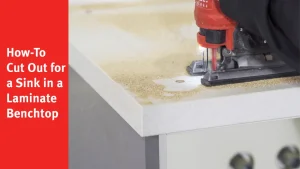Are you ready to upgrade your kitchen and make your daily routine smoother? Installing a kitchen drawer might sound tricky, but with the right steps, you can do it yourself—and save time and money.
Imagine opening a drawer that glides effortlessly, holding everything you need exactly where it belongs. In this guide, you’ll discover simple, clear instructions that anyone can follow, even if you’ve never done this before. Keep reading, and you’ll soon have a kitchen drawer that looks professional and works perfectly.
Your kitchen makeover starts now!
Tools And Materials Needed
Gathering the right tools and materials makes installing a kitchen drawer easier. Using proper equipment ensures smooth assembly and long-lasting results. Below are the essentials needed for this project.
Essential Tools For Installation
- Power drill with drill bits
- Screwdriver (Phillips and flathead)
- Measuring tape
- Level
- Pencil for marking
- Clamps to hold parts steady
- Hammer or rubber mallet
Materials Required
- Drawer slides (side or under-mount)
- Drawer box or pre-made drawer
- Screws (appropriate size for slides and drawer)
- Wood glue (optional for extra strength)
- Sandpaper for smoothing edges
Choosing The Right Drawer Slides
Pick slides that fit your drawer size and weight. Side-mount slides are common and easy to install. Under-mount slides offer a cleaner look but need precise fitting.
Safety Gear To Use
- Safety goggles to protect eyes
- Work gloves to avoid splinters
- Ear protection if using loud power tools
Preparing The Drawer Space
Preparing the drawer space is a key step before installation. It ensures the drawer fits well and works smoothly. Taking time to prepare avoids problems later.
Measure The Opening
Use a tape measure to check the width, height, and depth of the drawer opening. Measure at several points to find any variations. Note the smallest dimensions for a precise fit. Accurate measurements help avoid gaps or tight spots.
Clear And Clean The Area
Remove any items inside the cabinet or drawer space. Dust, dirt, and debris can block the drawer from sliding properly. Use a vacuum or cloth to clean every corner. A clean space prevents damage and allows smooth operation.
Assembling The Drawer Components
Assembling the drawer components is a crucial part of installing a kitchen drawer. This step ensures that the drawer fits perfectly and operates smoothly. Proper assembly provides stability and durability, making your kitchen more functional. Attention to detail during this phase helps avoid common problems like misalignment or sticking drawers.
Attach Drawer Slides
Start by selecting the right drawer slides for your drawer size and weight. Slides come in different types, such as side-mount or under-mount. Follow the manufacturer’s instructions for the best fit.
- Mark the slide positions inside the cabinet and on the drawer sides.
- Use a level to keep slides straight and even.
- Screw the slides securely in place with the correct screws.
- Test the slides by sliding the drawer in and out smoothly.
Build The Drawer Box
The drawer box forms the structure of your drawer. Use quality wood or plywood for strength and durability. Measure and cut the pieces accurately before assembly.
- Cut the front, back, sides, and bottom panels to size.
- Join the sides to the front and back panels using wood glue or screws.
- Attach the bottom panel securely to the frame.
- Sand all edges smooth to avoid splinters.
Double-check all joints for tightness and alignment. A well-built drawer box ensures easy movement and lasting use.
:strip_icc()/bhg-kitchen-drawer-slides_8pmLpaOPqRL84F5AQsbK3g-c0889a5c5ff04b5eafdc8bcd9018236c.jpg)
Credit: www.bhg.com
Installing Drawer Slides
Installing drawer slides can make your kitchen drawers smoother and more efficient. Align the slides carefully with the drawer edges. Secure them with screws for a sturdy fit.
Installing drawer slides is a crucial step in your kitchen drawer project. This task ensures your drawers open smoothly and last longer. It’s simpler than it seems, and with a little patience, you’ll get it right.Positioning The Slides
Start by marking the spots for your slides. Use a pencil and measure the height where each slide will go. Keep the slides level to prevent uneven drawer movement. It’s best to use a spirit level for accuracy. Place the slide against the drawer side to check fit. Ensure there’s enough space for easy opening and closing.Securing The Slides
Once positioned, it’s time to secure them. Hold the slide firmly in place. Use screws to attach the slide to the drawer side. Make sure the screws are tight, but don’t over-tighten. Over-tightening can damage the slide. Test the slide by moving it back and forth. This ensures it’s installed correctly. Repeat the process for the other side. Now your slides are ready for the drawer box.Fitting The Drawer Into The Cabinet
Fitting the drawer into the cabinet is a key part of the installation. This step ensures the drawer slides smoothly and fits perfectly. It requires careful alignment and testing to avoid future issues.
Aligning The Drawer
Start by holding the drawer in front of the cabinet opening. Make sure the slides on the drawer and cabinet match up.
Push the drawer gently inside, keeping it straight. Check that both sides are even and flush with the cabinet edges.
Adjust the position if needed. The drawer should move without tilting or scraping the sides.
Testing The Movement
Pull the drawer out slowly and push it back in to test the slide. It should glide smoothly without sticking.
Listen for any unusual sounds like squeaks or rubbing. These signals show the drawer needs more adjustment.
Try opening and closing the drawer several times. Confirm it stays level and doesn’t fall open or close too fast.

Credit: www.familyhandyman.com
Adjusting For A Perfect Fit
Adjusting for a perfect fit is a key step in installing a kitchen drawer. It ensures the drawer sits evenly and functions well. Small tweaks here make a big difference in use and appearance.
Fine-tuning Slide Placement
Check the drawer slides for proper alignment. Slides must be level and parallel to the cabinet sides. Use a level tool to confirm this. If the slides are off, loosen screws slightly. Shift the slides until they align perfectly. Tighten screws once the position is correct. Repeat this for both sides of the drawer. This adjustment prevents the drawer from sticking or wobbling.
Ensuring Smooth Operation
Open and close the drawer several times. Notice any resistance or noise. If the drawer sticks, check for obstacles on the slides. Clean the slides of dust or debris. Lightly apply lubricant designed for drawer slides. Avoid using heavy oils that attract dirt. Verify the drawer moves smoothly and quietly. Adjust the slide position again if needed. Smooth operation adds to the drawer’s durability and ease of use.
Finishing Touches
Finishing touches are what turn a simple drawer installation into a polished part of your kitchen. These final steps ensure your drawer not only works smoothly but also fits perfectly with your kitchen’s style. Paying attention to these details can save you time and effort later.
Installing Drawer Front
Attaching the drawer front is more than just screwing it in place. Align it carefully to avoid gaps or uneven edges that can ruin the look. Use clamps to hold it steady while you check the alignment from different angles.
Double-check the spacing around the drawer front to ensure it matches your other drawers. Small adjustments now prevent sticking or rubbing later. If your drawer front is heavy, consider using stronger screws or additional support brackets.
Adding Handles Or Knobs
Handles and knobs give your drawer character and make it easier to use. Choose hardware that complements your kitchen’s style—whether modern, rustic, or classic. Don’t rush this step; the right handle can change the whole feel of your kitchen.
Measure and mark the exact spots for screws before drilling to avoid mistakes. If you’ve ever struggled with misaligned handles, you know how frustrating it can be. Using a template can help keep everything consistent and save you from unnecessary holes in your drawer front.
Common Installation Issues
Installing a kitchen drawer may seem straightforward, but many encounter common issues that can frustrate the process. Identifying these problems early helps you avoid wasted time and effort. Let’s look at two frequent installation challenges and how you can tackle them effectively.
Drawer Sticking
Have you ever pulled a drawer only to have it stick halfway out? This usually happens when the drawer slides are not installed evenly or the drawer box is slightly warped. Check if any screws are too tight, causing the slides to bind.
Another cause can be debris or dust stuck in the slide tracks. Cleaning these tracks thoroughly can make a noticeable difference. You might also want to apply a small amount of lubricant designed for drawer slides to keep things moving smoothly.
If the drawer is still sticking, measure the clearance between the drawer sides and the cabinet opening. Is it uniform on both sides? Uneven spacing often causes sticking. Adjusting the slides or sanding down rough edges can help fix this problem quickly.
Misalignment Problems
Misaligned drawers not only look off but can also cause functionality issues. A common sign is a drawer front that sits unevenly or gaps that are wider on one side. This often results from inaccurate measurements during installation.
Make sure you use a level and a tape measure to position the slides precisely. Even a small deviation can cause the entire drawer to sit crooked. Sometimes, the cabinet itself might not be perfectly square, so take time to check that before attaching the drawer.
If you notice misalignment after installation, don’t hesitate to remove the drawer and reattach the slides. Adjusting the screws slightly can realign the drawer front. Have you experienced this? Taking the time to fix it now saves you from constant frustration later.

Credit: www.familyhandyman.com
Frequently Asked Questions
How Do I Measure For Kitchen Drawer Installation?
Measure the drawer opening width, height, and depth accurately. This ensures the drawer fits perfectly without gaps or tightness. Use a tape measure and double-check before purchasing or cutting materials.
What Tools Are Needed To Install A Kitchen Drawer?
You need a screwdriver, drill, tape measure, level, and screws. These tools help you attach slides and secure the drawer properly. Having the right tools speeds up installation and ensures a sturdy setup.
How Do I Install Drawer Slides Correctly?
Attach slides evenly on both drawer and cabinet sides. Use a level to keep them straight. Secure with screws and test the drawer for smooth sliding before finalizing.
Can I Install Kitchen Drawers Without Professional Help?
Yes, with basic tools and instructions, most can install drawers themselves. Follow step-by-step guides carefully for best results. DIY installation saves money and provides a sense of accomplishment.
Conclusion
Installing a kitchen drawer can be simple and quick. Follow the steps carefully and take your time. Use the right tools to avoid mistakes. Check the drawer fits well and slides smoothly. A well-installed drawer adds convenience to your kitchen.
Practice makes perfect, so don’t worry if it takes a few tries. Enjoy your neat and organized kitchen space. Keep your tools handy for future repairs or upgrades. Small projects like this boost your confidence. Happy installing!




